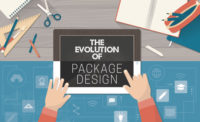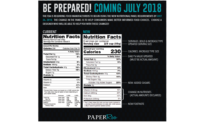Effective Packaging Requires Two Types of Designers
Understanding the roles involved in creating the perfect package.

You want to move your product to market quickly? Save time and money? Where do you start? How do you choose the right designer? To answer those questions you need to understand the two key design roles involved in creating the perfect package: a packaging engineer and a graphic package designer.
the graphic package designer
As the chief creative officer of Paper Roo Package Design and Branding, I’ve been helping customers all over the world create eye-catching packages. That’s how I know choosing the right designer is critical to helping the design process move smoothly, avoid problems and ultimately get the product on the shelf. One of the lessons I’ve learned is the importance of educating my customers on the differences between graphic package designers and graphic designers.
Graphic package designers have an entirely different creative process as compared to the graphic designer. I’ve seen the struggles companies have when getting their products to market when those differences aren’t recognized. Large corporations turn to marketing firms for help with their packaging artwork, but the marketing firms often don’t have designers that are proficient in designing artwork for packaging (because they’re usually marketing people who design PR campaigns and advertisements!). Little does the customer know, but the majority of graphic designers have no idea how to fold a box from its flat state. Ultimately, this leads to a long, drawn-out design process, frustration and thousands of dollars lost in packaging print mistakes.
Structural design is where the real product creativity starts. Yes, the branding plays an important role in drawing the consumer to the product on the shelf, but how the consumer interacts with your product is key to getting the product to the checkout counter and creating a long lasting impression in their mind. For example, Apple’s product packaging is not only amazing because of its clean and simple artwork, but also because it’s very well engineered structurally. Everything is strategically placed in a perfectly optimized box with stackable contents that allow the customer to dig into that new purchase. Making the structure in such a way that requires the consumer to interact with the product gives you the upper hand over the competition. With so much at stake, choosing the right designer is critical. packaging engineer versus graphic package designer
OK, so what is the difference between the two types of designers? To understand that, we first have to define the packaging engineer’s role. Packaging engineers design the box structure and functionality starting from a sample of the product. They use CAD software to generate a flat dieline of the box. Conversely, graphic package designers create the artwork that tells the product’s story. They use Illustrator and Photoshop software, and then they apply the artwork to the dieline. Generally speaking, engineers do not design artwork and graphic package designers do not engineer the box structure. These are two different skill sets that are typically completed by two different people.
There are exceptions to that rule, though. I’m one of them. I’ve spent years mastering the elements of the entire process and am able to effectively deliver all aspects from beginning to end. I am able to effectively engineer the boxes, create the brand for the product, create the artwork for the structure, manufacture the folding cartons and deliver to the production facility. But, I am a rarity because it takes years of painstaking training.
At the age of 18, I was trained by a very talented packaging engineer in the pharmaceutical industry. That allowed me to understand the engineering side of the business because I spent years just engineering box structures. Graphic design was always a strength of mine, and I wanted to apply it strictly to packaging. Throughout the years, working as a structural engineer, I started creating new packaging artwork for clients and helping with hiccups in their current artwork. It was at that point that I knew I needed to understand the box manufacturing process, so I spent a year as a folding carton converter learning the ins and outs of offset printing, printing plate making, die cutting and gluing.
Again, there’s a reason why it’s a rarity.
graphic packaging designers must know structural basics
Graphic designers are proficient in visual communication, combining typography, graphics and images. They use these skills to convey information through various types of advertisements, marketing materials and company literature. Now most people will argue, “Isn’t that what a graphic package designer does?” Yes and no.
A graphic package designer is skilled in using the visual communication process combining all the elements previously mentioned while also having the knowledge of packaging functionality and the ability to read and understand flat CAD dielines. At a minimum, a graphic package designer needs to understand the basic engineering process of folding a box and the functionality of thousands of different box styles from a flat, unglued state in order to place the artwork properly. Furthermore, they have to also know the manufacturing process of sealed bags, pouches, cups, etc. It can get complicated very quickly.
Understanding the basic engineering elements helps graphic package designers create artwork properly and strategically so, when folded, the artwork falls on the correct panels and doesn’t get caught up in a glue seam or a tuck flap. Using a graphic designer who doesn’t have knowledge in folding cartons and other packaging materials can be a costly mistake. It can slow down the design process and also cause complications during manufacturing.
I’ve seen numerous costly mistakes on the manufacturing side, such as barcodes getting caught up on internal panels when they’re supposed to be on the bottom of the box, ingredient statements falling into the glue seam, artwork placed on the wrong panels. You name it, I’ve seen it. Sadly, I’ve also seen skids and skids of finished product get thrown in the trash because of mistakes that could have been avoided if there was an experienced graphic package designer involved.
Let’s face it, the packaging is the first thing the consumer sees. And it’s expensive! Sometimes it’s more expensive than the product it’s holding. So, it is a significant investment to hire both a packaging engineer and a graphic package designer. But, if you can find a quality service that provides both offerings, the costs can be substantially less. It’s just a matter of finding that right person.
I created Paper Roo Package Design and Branding to offer a one-stop, comprehensive packaging service. I wanted to apply my unique skillset to help my customers achieve their packaging needs from start to finish because I know how hard it is to find such a combination. To be able to engineer their carton, create stunning artwork, manufacture all their folding cartons and have them on the dock ready for production—well, that’s a big task.
Regardless of what you choose, do your homework and research about the designer so you can make the right decision from the start. Know what skill set you’re paying for. This is sure to help save you a lot of headaches (and money) in the long run.
Looking for a reprint of this article?
From high-res PDFs to custom plaques, order your copy today!





